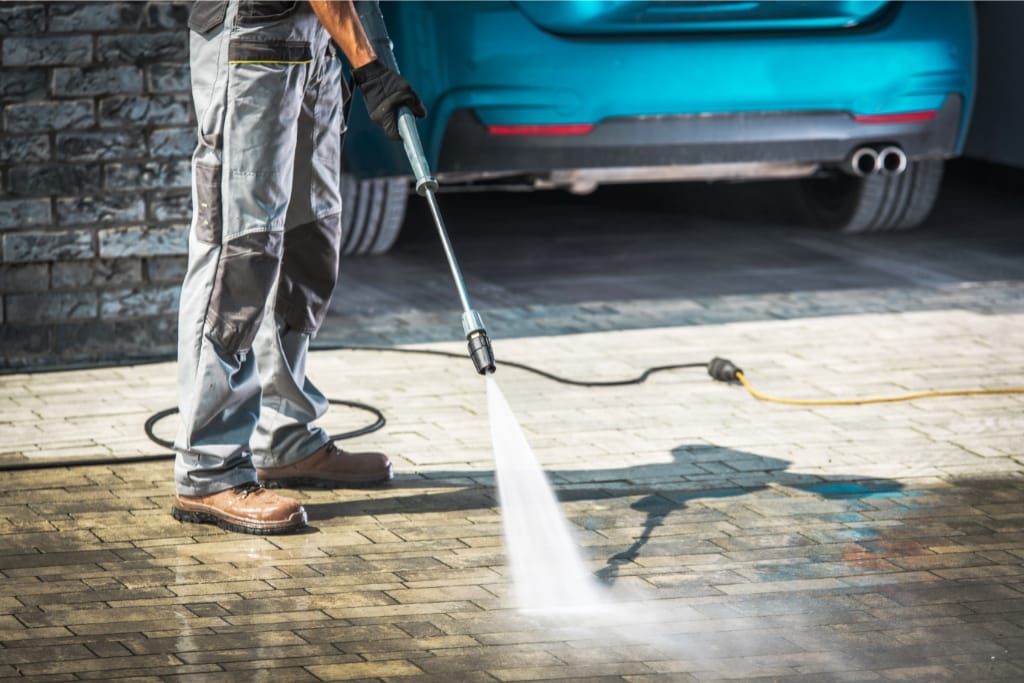Driveway algae is a common problem that develops in areas with high levels of moisture and shade.
Algae thrive in damp environments, often forming on concrete, asphalt, or brick surfaces that are frequently exposed to water or humidity and receive limited sunlight.
These conditions create the perfect breeding ground for algae, leading to green, slippery patches that can be both unsightly and hazardous.
If left untreated, algae can cause discoloration and even damage the surface over time, making it essential to address the issue promptly to maintain the driveway's appearance and safety.
Understanding why algae occur is the first step in effectively combating the problem.
Removing algae from your driveway is crucial not only for preserving its aesthetic appeal but also for ensuring safety.
Algae growth creates green or dark stains that can make the surface appear dirty and unkempt, diminishing the overall curb appeal of your property.
More importantly, algae form slippery patches that pose a serious hazard, especially after rain, increasing the risk of slips and falls for residents and visitors.
Addressing this problem promptly helps maintain a clean, attractive driveway while also eliminating potential dangers, ensuring a safer and more visually pleasing outdoor space for everyone.
Tackling driveway algae involves a straightforward process that includes assessment, removal, and prevention.
First, it’s important to inspect the area to determine the severity of algae growth and gather the necessary tools.
Next, the removal process can begin by scrubbing the affected surface with soapy water, applying an algae-killing solution, and thoroughly rinsing the area.
Finally, to prevent future growth, steps such as improving drainage, applying a sealant, and regularly cleaning the driveway should be implemented.
This comprehensive approach ensures both the immediate removal of algae and long-term protection for a cleaner, safer surface.
Step 1: Assess The Problem
Before taking action to remove algae from your driveway, it is essential to assess the extent and nature of the problem.
This step involves thoroughly inspecting the driveway to identify areas affected by algae growth and evaluating the severity of the issue.
A clear understanding of the problem will help ensure that you use the right methods and materials for effective removal.
Preparing the necessary tools and supplies during this stage will make the cleaning process smoother and more efficient.
Careful assessment lays the foundation for successfully tackling the algae and restoring your driveway to its original condition.
Inspect And Identify Algae-Affected Areas On The Driveway
The first step in addressing driveway algae is to thoroughly inspect and identify the areas where algae growth is present.
Look for green, black, or dark patches that often stand out against the driveway’s surface, especially in shaded or damp sections.
Pay close attention to areas near gutters, water drains, or spots where moisture tends to accumulate, as these conditions promote algae growth.
It’s also crucial to examine different sections of the driveway under varying light conditions, as algae may not always be immediately noticeable.
Taking the time to pinpoint all affected areas ensures that no spots are overlooked during the cleaning process, leading to more effective results.
Determine The Severity Of The Algae Growth
Determining the severity of algae growth on your driveway is an important step in tailoring the cleaning approach to the level of the problem.
Light growth may consist of thin greenish patches that are easy to remove with basic cleaning methods, while severe growth can involve thick, slippery layers that have spread across large portions of the surface.
Assess how extensive and entrenched the algae are by observing its coverage, thickness, and texture.
Consider whether the algae has caused discoloration or surface damage, which may require more intensive solutions.
Understanding the severity of the growth helps ensure you choose the most effective materials and techniques for the job.
Gather Required Tools And Materials For Algae Removal
To effectively remove algae from your driveway, it is essential to gather the proper tools and materials beforehand.
Start by assembling basic cleaning equipment, such as a stiff-bristled brush, a bucket, and a garden hose or pressure washer.
You will need a cleaning solution suitable for algae removal—this could be a store-bought algae cleaner, a diluted bleach mixture, or an eco-friendly homemade solution.
Protective gear, including gloves and safety goggles, is also recommended to safeguard against irritants during the cleaning process.
For stubborn or extensive algae growth, consider using a scraper or specialized tools designed for deep cleaning.
Having all the necessary supplies on hand ensures that the removal process is efficient, thorough, and safe.
Step 2: Remove Algae Effectively
Once the problem has been assessed and the necessary tools have been gathered, it’s time to focus on the effective removal of algae from your driveway.
This step involves applying the right cleaning techniques to eliminate algae thoroughly while minimizing damage to the surface.
By following a systematic approach, including scrubbing, treating, and rinsing, you can ensure a cleaner and safer driveway.
Proper execution during this stage not only removes current algae growth but also helps prepare the surface for preventive measures to keep algae from returning.
Scrub The Surface Using A Stiff Brush And Soapy Water
Scrubbing the surface of your driveway with a stiff brush and soapy water is a highly effective way to tackle algae growth.
Begin by mixing a solution of warm water and a suitable detergent in a bucket to create soapy water that can loosen the algae.
Next, use a stiff-bristled brush to vigorously scrub the affected areas, applying enough pressure to break up the algae without damaging the driveway’s surface.
Pay extra attention to heavily infested spots, ensuring the soap penetrates and lifts the algae from the surface.
This method not only removes visible algae but also helps dislodge spores, reducing the likelihood of regrowth.
Once the scrubbing is complete, the surface will be prepped for further cleaning or treatment.
Apply An Algae-Killing Solution Or Homemade Remedy To The Affected Areas
Applying an algae-killing solution or a homemade remedy is a crucial step in ensuring the effective and lasting removal of algae from your driveway.
Begin by selecting a suitable treatment, such as a commercial algae cleaner, a diluted bleach solution, or an eco-friendly option like a vinegar and water mixture.
Carefully apply the solution to the affected areas, ensuring thorough coverage, especially in spots where algae growth is dense.
Allow the treatment to sit for the recommended time, usually 10–20 minutes, to break down and kill the algae effectively.
Be sure to follow safety precautions, such as wearing gloves and avoiding direct skin contact with the solution.
This step not only eliminates existing algae but also helps to neutralize spores, preventing future growth and keeping your driveway clean and safe.
Rinse Thoroughly With A Pressure Washer Or Garden Hose
Rinsing your driveway thoroughly with a pressure washer or garden hose is essential to remove any remaining traces of algae and cleaning solution.
Start by using a pressure washer if available, as its high-powered spray can effectively dislodge stubborn algae and debris from the surface.
Adjust the pressure setting to ensure it’s strong enough to clean but not so intense that it damages the driveway's material.
If you’re using a garden hose, attach a spray nozzle to increase water pressure and focus on hitting the treated areas with a concentrated stream of water.
Be meticulous in covering all sections, as leftover cleaning solutions or algae residue can lead to regrowth.
A thorough rinse leaves your driveway clean, safe, and ready for potential sealing or preventative treatments.
Step 3: Prevent Future Algae Growth
Preventing future algae growth is a critical step in maintaining the cleanliness and longevity of your driveway.
By addressing the conditions that promote algae development, such as excessive moisture and poor drainage, you can reduce the likelihood of regrowth.
Employing proactive measures, including sealing the surface, improving sunlight exposure, and keeping the area free of debris, creates an environment that is less hospitable to algae.
Taking the time to implement these preventative strategies will not only save you effort in the long term but will also help preserve the appearance and functionality of your driveway.
Improve Drainage Around The Driveway To Minimize Moisture Buildup
Improving drainage around the driveway is an effective way to minimize moisture buildup, which is a primary factor in algae growth.
Start by inspecting the area for poor drainage spots where water tends to accumulate after rainfall or irrigation.
Consider installing a drainage system, such as French drains or a channel drain, to redirect excess water away from the driveway.
Grading the surrounding soil to ensure a gentle slope away from the driveway can also help prevent standing water.
Clearing nearby gutters and downspouts ensures water flows efficiently and doesn’t pool around the driveway.
By addressing drainage issues, you create a drier environment that discourages algae growth, keeping your driveway cleaner and safer over time.
Apply A Protective Sealant To The Driveway Surface
Applying a protective sealant to the driveway surface is an excellent way to safeguard it from future algae growth and environmental wear.
A high-quality sealant creates a durable, water-resistant barrier that prevents moisture from penetrating the porous surface of the driveway, which is a key factor in algae formation.
Start by selecting a sealant compatible with your driveway material, be it concrete, asphalt, or pavers.
Before application, ensure the surface is clean, dry, and free from debris to allow the sealant to bond effectively.
Using a roller or sprayer, evenly coat the driveway, following the manufacturer’s instructions for drying and curing times.
Regularly reapplying the sealant as recommended will enhance its protective properties, maintaining the appearance and longevity of your driveway while reducing the chances of algae returning.
Establish A Regular Cleaning And Maintenance Routine
Establishing a regular cleaning and maintenance routine is vital for preventing algae growth and keeping your driveway in optimal condition.
Begin by sweeping the driveway regularly to remove debris, such as leaves, dirt, and other organic matter, which can trap moisture and contribute to algae formation.
Periodically wash the surface with a garden hose or pressure washer to eliminate grime and prevent buildup.
Inspect the area for signs of algae, cracks, or drainage issues, addressing them promptly to avoid long-term problems.
Incorporating these simple actions into your routine will ensure a clean, safe, and visually appealing driveway while reducing the likelihood of algae regrowth and costly repairs.
Conclusion
Effectively addressing algae growth on your driveway is essential for maintaining its safety, functionality, and aesthetic appeal.
By promptly removing algae and implementing preventative measures, you mitigate the risks of slippery surfaces and potential damage caused by prolonged moisture exposure.
Strategies such as improving drainage, applying a protective sealant, and establishing a regular maintenance routine work together to create a cleaner and more durable driveway.
Taking these proactive steps not only enhances the overall appearance of your property but also minimizes future cleaning efforts and repair costs.
A well-maintained driveway reflects care and attention, ensuring it remains a safe and welcoming feature of your home.
Maintaining a clean and algae-free driveway offers numerous benefits that extend beyond aesthetic appeal.
A pristine driveway enhances the overall look of your property, boosting curb appeal and potentially increasing its value.
It ensures a safer environment by eliminating the slippery surfaces caused by algae, reducing the risk of accidents for both residents and visitors.
A clean driveway also requires less effort for upkeep over time, as proactive maintenance prevents the buildup of stubborn grime and organic growth.
Furthermore, protecting the surface from algae growth preserves the structural integrity of the driveway, prolonging its lifespan and saving you money on repairs or replacements in the long run.
By prioritizing regular cleaning and preventative measures, you can enjoy a driveway that remains functional, safe, and visually appealing year-round.
Encouraging proactive prevention to avoid future issues with algae growth is a smart approach to driveway maintenance.
Taking preemptive measures, such as enhancing drainage, applying protective sealants, and establishing a consistent cleaning routine, helps address potential problems before they arise.
Regular inspections allow you to catch and resolve early signs of moisture buildup or organic growth, stopping algae in its tracks.
Preventative efforts preserve the driveway’s durability and appearance, reducing the need for expensive repairs or intensive cleaning down the line.
By staying ahead through thoughtful planning and maintenance, you ensure your driveway remains a safe, attractive, and long-lasting part of your home.
Download Our Free E-book!







